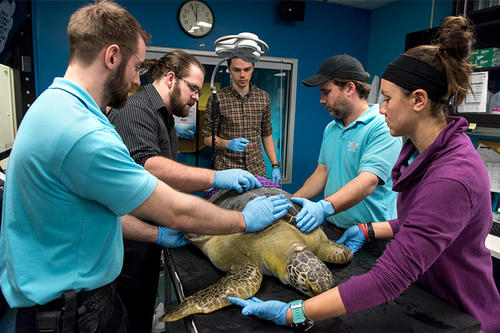
In February 2011, Seemore the green sea turtle came to the SEA LIFE Minnesota Aquarium from a turtle hospital in Florida. A 2009 collision with a boat had damaged her shell and trapped air beneath it, giving her “bubble butt syndrome.”
This condition forces Seemore to swim with her rear end sticking up and keeps her from diving normally. Her care team at SEA LIFE attaches weights to the shell to correct her buoyancy, but must continually replace them when she sheds scutes (plates on the shell).
Because replacing the weights causes Seemore stress, she needed a better method for readjusting her buoyancy. Since last summer, a team of mostly undergraduate University of Minnesota students has been designing one for her.
Printing a prosthesis
“The whole process has been really exciting,” says design team lead Alex Barrette, a mechanical engineering student. “It’s something a mechanical engineer doesn’t typically see, and it’s been challenging.”
After a June 2017 CT scan at the U’s Veterinary Hospital, the students, led by mechanical engineering graduate student Davis Fay, took the data and started designing a shell prosthesis—called an exoshell—for the 100-pound turtle. Using equipment from the U’s Institute for Engineering in Medicine 3-D Printing Core, the team printed a 3-D prototype exoshell.
“I’d had some experience with 3D printing in high school and college,” says team member Tom Skahen, an aerospace engineering major. “I could use the software, run the printers, and explore the options we could use. I was really self-driven.”
In January 2018 Fay and Barrette performed a fitting of the prototype on Seemore at SEA LIFE. The team hopes to have a permanent exoshell this summer. Then Seemore will be able to swim and dive more normally, and, says Fay, “if she gets hung up, she’ll be able to break it off.”
- Categories:
- Science and Technology





